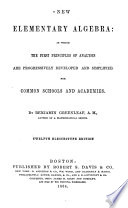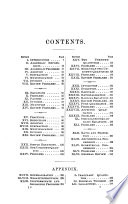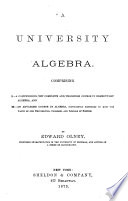 | Benjamin Greenleaf - Algebra - 1864 - 336 pages
...rationalize a binomial surd containing only the square root. 1. Rationalize \/a + V^OPERATION. Since the product of the sum and — - difference of two quantities is equal V^~TV* to the difference of their squares y'a — \jb (Theo. III. Art. 78), we multiply the . ,—... | |
 | Paul Allen Towne - Algebra - 1865 - 314 pages
...— 2y)" and (a; — 4)2 when a; = 4, y = 1. 64. Since (x-\-y) (x — y) = a? — y3, it follows that The product of the sum and difference of two quantities is equal to the difference of their squares. EXAMPLES. 1. (a + 6) (a — 6) = a* — 6s. 2. (2a + 6) (2a — 6) = 4a" — 6". 3. O + 4) (a; —... | |
 | Joseph Ray - Algebra - 1866 - 420 pages
...4xy+y*. 3. (3x— 52)2=9x2— 3(te2+25z2 4. (a«— 3cx)2=a2zz— 6acz2+9c2z2. SO. Theorem III. — The product of the sum and difference of two quantities, is equal to the difference of their squares. Let a represent one of the quantities, and 6 a -f 6 the other. a —6 Then, aj-6= their sum, and a... | |
 | Joseph Ray - Algebra - 1852 - 422 pages
...(2x— j03=4 3. (3*— 52)2=9 4. (az — 3cx)-=a?z3— 6 ART. 8O. THEOREM III. — The product of tlie sum and difference of two quantities, is equal to the difference of their squares. Let a represent one of the quantities, and b the other ; then a+i=their sum, and a — 6=their difference.... | |
 | William Frothingham Bradbury - Algebra - 1868 - 264 pages
...y. Ans. a;2 — 2xy-\-y2. 2. 2x — ±y. 3. x—1. Ans. a;2 — 2a:+ 1. 4. lx — 2. THEOREM IV. 60t The product of the sum and difference of two quantities is equal to the difference of their squares. Let a -\- b be the sum, and a — b the difference of the two quantities a and b. PROOF. a + b a —b... | |
 | Robert Wallace - 1870 - 164 pages
...theorem for finding the product of the sum and difference of two quantities is deduced. THEOREM III. — The product of the sum and difference of two quantities is equal to the difference of the squares of those quantities. EXAMPLES. 3xm -\-2y°) (3xm — 2y")=9a;2m — 4^-°. Ans. a;+*)(a;-$)=a;2—... | |
 | James Haddon - Algebra - 1871 - 244 pages
...difference of two quantities is equal to ' the sum of their squares, diminished by twice their product. 3. The product of the sum and difference of two quantities is equal to the difference of their squares. The student is recommended to commit these three theorems to memory. DIVISION. VII Division is just... | |
 | William Frothingham Bradbury - Geometry - 1872 - 262 pages
...28) B D2 = A B2 — A D2 B _ 46V— (6»+ c2 — a*)' _ AC X BD _ 6 ! iV ;*—(i? + a' — 6')' 16 As the product of the sum and difference of two quantities is equal to the difference of their squares, we have But 2 be — (62 + c' — a2) = a2 — (I2— 2 be -\- c2) = a2— (6 — c)a and a2— (6—... | |
 | Daniel Barnard Hagar - Algebra - 1873 - 278 pages
...a*-2a? + 1. 4. What is the square of 3a*-8a2? 5. Expand (5s3 - 2cd)(5a;s - 2cd). Ttieorem III. 115. The product of the sum and difference of two quantities is equal to the difference of their squares. For, let a and b represent the two quantities, then a+b will denote their sum, and a — b their difference,... | |
 | Edward Olney - Algebra - 1873 - 354 pages
...square of the first, minus twice the product of the two, plus the square of the second. 87. THEO. — The product of the sum and difference of two quantities is equal to the difference of their squares. EXAMPLES. 1. Multiply together 3ax, — 3a*x*, 4by, — y*, and %x*y*. 2. Multiply together 3x*, —... | |
| |